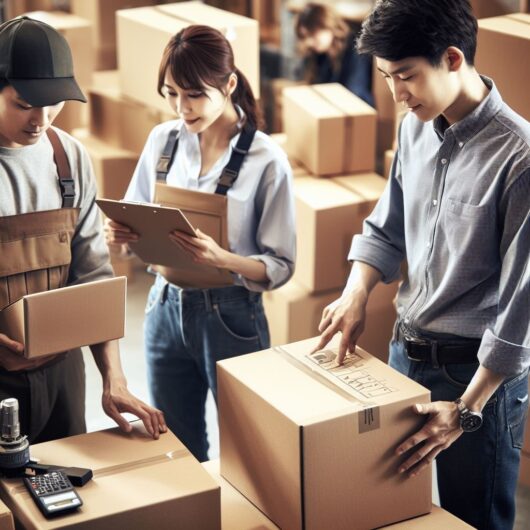Industrial cardboard boxes are the unsung heroes of the logistics and shipping world. They come in various shapes and sizes, but their purpose is clear: to protect, store, and transport goods efficiently. In this comprehensive guide, we’ll dive deep into the world of industrial cardboard boxes, exploring their types, manufacturing processes, sustainability, and the vital role they play in modern commerce.
The Anatomy of Industrial Cardboard Boxes

- Understanding the Structure: Single-wall vs. Double-wall vs. Triple-wall
- When it comes to industrial cardboard boxes, one size certainly does not fit all. These boxes vary in structural design, with single-wall, double-wall, and triple-wall options. Single-wall boxes are lightweight and suitable for most applications, while double-wall and triple-wall boxes offer enhanced durability and stacking strength.
- Flutes and Their Significance: A, B, C, E, and F Flutes
- The flutes in cardboard boxes are the corrugated layers that provide strength and cushioning. Understanding the different flute types, such as A, B, C, E, and F, is crucial for selecting the right box for your needs. Thicker flutes offer more protection, while thinner ones are ideal for lightweight items.
- Common Box Styles: RSC, FOL, HSC, and More
- There’s more to cardboard box styles than meets the eye. RSC (Regular Slotted Container), FOL (Full Overlap), HSC (Half-Slotted Container), and others each serve specific purposes. Knowing which style to choose can streamline your packaging process and save you money.
- Specialized Boxes for Unique Applications: Hazmat, Gaylord, and Bulk Boxes
- In certain industries, standard cardboard boxes won’t cut it. Hazardous materials require Hazmat boxes, and Gaylord boxes are designed for bulk storage. Understanding these specialized boxes ensures the safe handling of unique goods.
How Industrial Cardboard Boxes Are Made
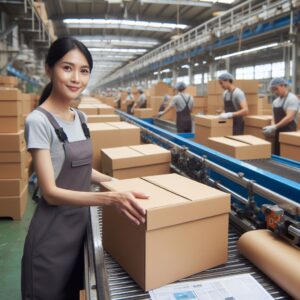
- The Raw Materials: Kraft Paper and Linerboard
- At the core of industrial cardboard box production lie two essential raw materials: kraft paper and linerboard. Kraft paper, derived from wood pulp, is revered for its strength and versatility. When combined with linerboard, a flat, heavy-duty paper, these materials form the building blocks of robust and environmentally friendly packaging solutions. Their inherent recyclability aligns with sustainability goals, making them a responsible choice in the packaging industry. The selection of these materials marks the initiation of a manufacturing journey dedicated to creating boxes that not only endure but also contribute to eco-conscious practices.
- The Corrugating Process: Creating the Flutes
- The corrugating process is a pivotal step in shaping the structural integrity of an industrial cardboard box. This intricate process involves adhering the linerboard to the corrugated medium, resulting in the distinctive flutes that define the box’s strength and cushioning properties. The arrangement of these flutes plays a crucial role in the box’s ability to withstand external forces and provide protective insulation for its contents. In essence, the corrugating process is the backbone of a well-engineered cardboard box, ensuring it possesses the resilience required for various packaging applications.
- Box Manufacturing: Cutting, Printing, and Gluing
- Once the foundation is set, manufacturers employ precision techniques to transform the corrugated sheets into functional and visually appealing boxes. Precision cutting ensures that each box adheres to specified dimensions, providing consistency in the packaging process. Custom printing becomes an invaluable tool at this stage, allowing businesses to showcase their brand identity and enhance the visual appeal of their products.
- Quality Control in Box Production
- In the realm of industrial cardboard box manufacturing, quality control is a non-negotiable element. Rigorous inspections are implemented to ensure that each box meets stringent industry standards and, most importantly, aligns with customer expectations. From verifying the precision of cuts to assessing the clarity of prints, every aspect undergoes scrutiny.
Choosing the Right Industrial Cardboard Box
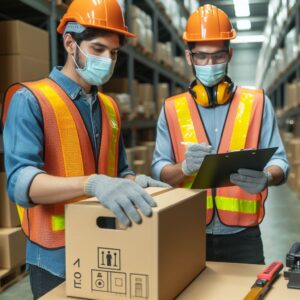
- Factors to Consider: Weight, Size, Fragility, and Destination
- Selecting the right cardboard box involves considering factors like the weight and size of your items, their fragility, and the destination. A well-chosen box protects your goods and minimizes shipping costs.
- Sustainability and Recyclability: Eco-friendly Choices
- In today’s eco-conscious world, sustainability matters. Learn about eco-friendly cardboard box options and how they contribute to a greener planet.
- Customization Options: Branded Boxes and Printing Techniques
- Customization options allow you to create branded boxes that make an impression. Explore various printing techniques and design possibilities to elevate your packaging.
- Cost vs. Quality: Striking the Right Balance
- Balancing cost and quality is essential for businesses. Discover strategies to find cost-effective solutions without compromising on the integrity of your packaging.
Industrial Cardboard Boxes in Logistics and Shipping
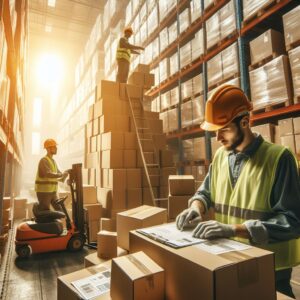
- The Logistics Puzzle: Role of Cardboard Boxes in Supply Chain Management
- Delve into the integral role of cardboard boxes in the intricate puzzle of supply chain management. Serving as the linchpin, these boxes play a vital role in orchestrating the seamless movement of goods from manufacturers to consumers. Explore how cardboard boxes facilitate efficient logistics, providing a standardized and versatile solution for the packaging and transportation of products.
- Packaging Design for Safety: Protecting Goods During Transit
- Effective packaging design is paramount to safeguarding goods throughout their journey. Uncover the strategies and safety measures embedded in packaging design that ensure products reach their destination intact. From selecting appropriate cushioning materials to creating secure configurations within the box, explore how packaging solutions contribute to minimizing damage during transit.
- How E-commerce Has Transformed Cardboard Box Usage
- Witness the transformative impact of e-commerce on the usage of cardboard boxes. As online shopping takes center stage, explore how these boxes have adapted to meet the unique demands of e-commerce logistics. From tailored sizes to accommodate diverse products to innovations in packaging for easy returns, discover the evolution of cardboard box usage in response to the dynamic landscape of online retail.
Sustainability and Cardboard Boxes

- The Green Side of Cardboard: Renewable and Recyclable
- Cardboard’s green credentials are a major asset. Dive into its renewability and recyclability, and understand why it’s an environmentally responsible choice.
- Innovative Eco-friendly Practices: Biodegradable and Reduced Packaging
- Stay updated on the latest eco-friendly practices in the cardboard box industry, from biodegradable materials to reduced packaging waste.
- Reducing the Carbon Footprint: Recycling and Repurposing
- Learn how recycling and repurposing cardboard boxes contribute to reducing the carbon footprint, making the world a cleaner and greener place.
The Art of Packing Industrial Cardboard Boxes
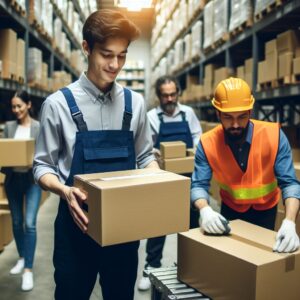
- Proper Packing Techniques: Wrapping, Cushioning, and Securing
- Mastering the art of packing industrial cardboard boxes is a critical skill to ensure the safe transit of your items. Dive into proper packing techniques, where the trifecta of wrapping, cushioning, and securing takes center stage. Learn the intricacies of selecting appropriate wrapping materials, providing sufficient cushioning to protect against shocks and impacts, and securing items within the box to prevent movement during transportation.
- Avoiding Common Pitfalls: Over packing and Under packing
- In the art of packing, striking the right balance is paramount to optimize both efficiency and protection. Explore common pitfalls such as over packing, which not only wastes resources but can also lead to increased shipping costs. On the flip side, under packing poses the risk of damage to your items during transit.
- Fragile Items and Special Handling: Tips and Tricks
- Certain items demand extra attention and care during packing. Uncover valuable tips and tricks for handling fragile and delicate goods, ensuring they reach their destination intact. From choosing appropriate cushioning materials to adopting strategic packing configurations, delve into the nuances of safeguarding items that require special handling.
The Future of Industrial Cardboard Boxes

- Technological Advancements: Smart Packaging and Tracking
- The trajectory of industrial cardboard boxes is evolving through technological advancements, particularly in the realm of smart packaging and tracking. The future promises a seamless integration of technology, where cardboard boxes become more than just containers. Explore how smart packaging innovations, such as RFID (Radio-Frequency Identification) and IoT (Internet of Things), are revolutionizing the industry. These technologies enable real-time tracking, ensuring enhanced supply chain visibility and product traceability.
- Sustainability Initiatives: Circular Economy and Beyond
- Sustainability takes center stage in the future landscape of industrial cardboard boxes. Beyond being mere containers, cardboard boxes are becoming flag bearers of environmental responsibility. Delve into sustainability initiatives, with a particular focus on the circular economy. Explore how manufacturers are embracing practices that prioritize recycling, reuse, and minimizing environmental impact.
- Challenges and Opportunities in the Cardboard Box Industry
- As the future unfolds, the cardboard box industry navigates a landscape filled with both challenges and opportunities. Stay abreast of the evolving dynamics that shape cardboard box manufacturing. Challenges may include adapting to changing consumer preferences, addressing environmental concerns, and meeting stringent regulatory standards. Simultaneously, opportunities emerge in the form of innovative designs, expanding markets, and the integration of advanced materials.
Cardboard Box DIY and Repurposing
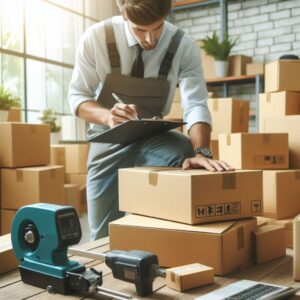
- Creative Ways to Repurpose Cardboard Boxes: Home Decor, Crafts, and More
- Unleash your imagination with a myriad of DIY cardboard box projects that transcend the ordinary. From crafting makeshift furniture pieces and ingenious organizers to constructing whimsical playhouses for children, the potential of cardboard boxes knows no bounds. Transform discarded boxes into personalized storage solutions that declutter your space, or create a cozy play corner for kids to explore their imagination.
- DIY Cardboard Box Projects: Furniture, Organizers, and Playhouses
- Unleash your imagination with a myriad of DIY cardboard box projects that transcend the ordinary. From crafting makeshift furniture pieces and ingenious organizers to constructing whimsical playhouses for children, the potential of cardboard boxes knows no bounds. Transform discarded boxes into personalized storage solutions that declutter your space, or create a cozy play corner for kids to explore their imagination.
- Cardboard Box Art: The Intersection of Creativity and Recycling
- Witness the artistic transformation of cardboard boxes as they transcend their utilitarian origins and become canvases for creative expression. In the realm of cardboard box art, explore how artists utilize these humble materials to craft visually stunning and environmentally conscious creations. From intricate sculptures to abstract installations, cardboard box art embodies the intersection of creativity and recycling.
Conclusion
In conclusion, industrial cardboard boxes are the unsung heroes of modern commerce. They offer versatility, sustainability, and protection for your goods. As you navigate the world of logistics, remember that the humble cardboard box plays a pivotal role in ensuring that products reach their destination intact. At BlueRose Packaging, we offer a wide range of packaging supplies and solutions that meet the unique requirements of various industries. Visit our website, https://www.bluerosepackaging.com/ to explore our comprehensive range of packaging supplies and discover how we can assist in safeguarding your valuable products.

